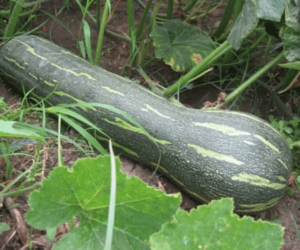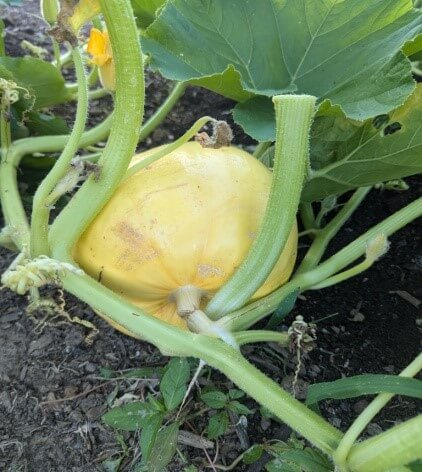 Our pumpkin and winter squash plants are battling the weeds and winning! (Thank you to everyone who helped spread a weed-blocking tarp over the winter and followed up with battling weeds over the past month– please keep it up!)
Our pumpkin and winter squash plants are battling the weeds and winning! (Thank you to everyone who helped spread a weed-blocking tarp over the winter and followed up with battling weeds over the past month– please keep it up!)
The pumpkin patch covers about three rows on the Moredon Road side of the garden. It features a dozen different varieties, including orange field, pie, and mini pumpkins; spaghetti and hubbard squash; and distinctive heirloom winter squash. One of these heirlooms, the Lunga di Napoli, is an elongated Italian variety with blue-green skin that can grow to 50 pounds. Cushaws are an American variety, generally grown in the South and Southwest; they feature green (or orange) and white stripes and are shaped like giant (up to 30 pounds) butternut squash. Both heirlooms are prized by cooks for sweet or savory dishes.
Our nine giant pumpkin plants are in the center of the patch. Two have already started to produce fruit, though one pumpkin has a broken stem and may not survive to maturity. In the coming weeks, we will need to thin some of the weaker giant pumpkin vines to make room for the more vigorous plants. Starting with extra plants hopefully means that some will survive even if others are lost from pests such as the squash vine borer, a caterpillar that bores into pumpkin or winter squash vines and kills the plant within a few days if not detected and cut from the stem. We will need healthy vines growing in rich soil, with full sun and regular rain, to produce a 1,000 pound pumpkin!
Pumpkins and winter squash require 90 – 120 days of growth until harvest. Our plants were sown in late spring, to allow for harvest in late summer or early fall. After hardening off in the sun, the pumpkins and squash can keep for up to a year (possibly even two years – I’ve experimented!) and still be good to eat.
submitted by Aaron Rubin

